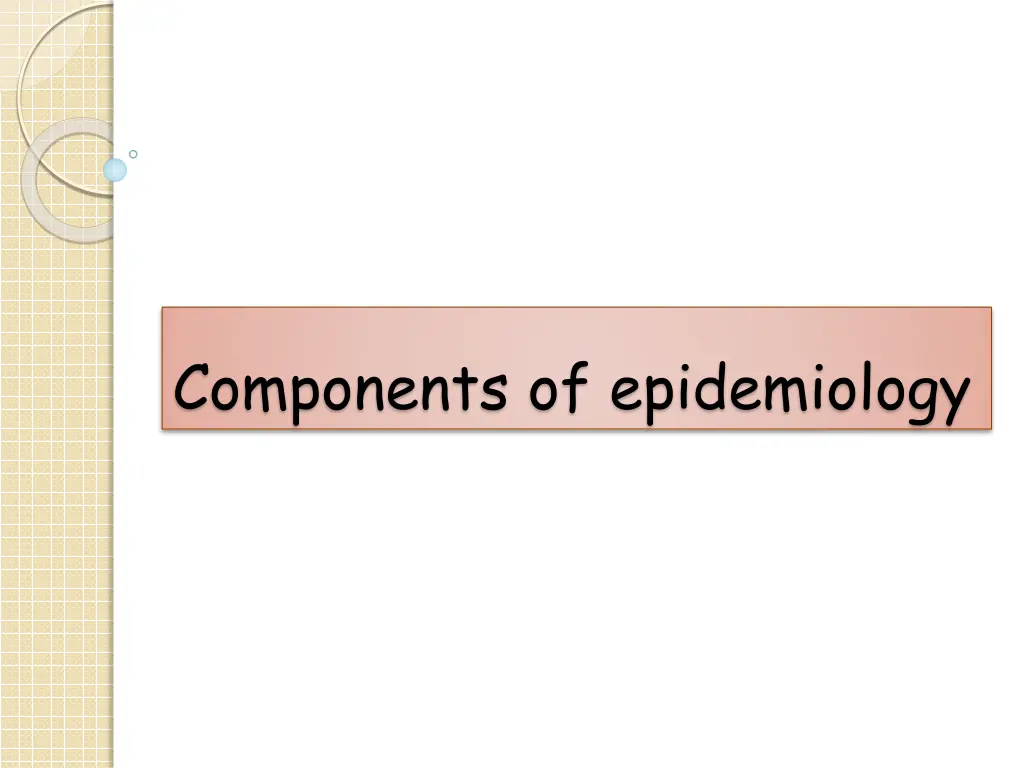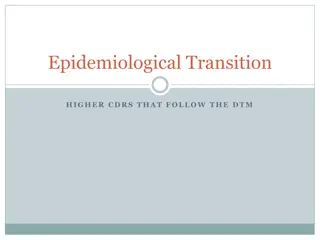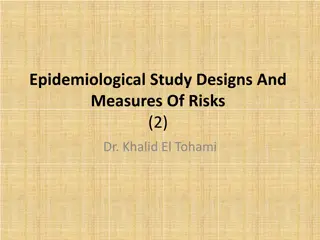
Understanding the Components of Epidemiology
Explore the key components of epidemiology, including data collection, qualitative and quantitative methods, monitoring, surveillance, and screening. Learn about the types of surveys used in epidemiological studies and the importance of observational and experimental approaches in assessing disease impact.
Download Presentation

Please find below an Image/Link to download the presentation.
The content on the website is provided AS IS for your information and personal use only. It may not be sold, licensed, or shared on other websites without obtaining consent from the author. If you encounter any issues during the download, it is possible that the publisher has removed the file from their server.
You are allowed to download the files provided on this website for personal or commercial use, subject to the condition that they are used lawfully. All files are the property of their respective owners.
The content on the website is provided AS IS for your information and personal use only. It may not be sold, licensed, or shared on other websites without obtaining consent from the author.
E N D
Presentation Transcript
First component: data collection Qualitative Quantitative Natural history of disease Surveys Monitoring Causal hypothesis testing Surveillance Studies Experimental Modelling Assessing economical impact disease Observational Cross-sectional Cohort Case-control the of
Quantitative investigation 1. Surveys: An examination of an aggregate of units A group of animals is an example of an aggregate Can be undertaken on a sample of the population The examination usually involves counting members of the aggregate & characteristics of the members Ex. Presence of particular diseases, or production parameters such as milk yield Types: 1. A cross- sectional survey records events occurring at a particular point in time 2. A longitudinal survey records events over a period of time
Quantitative investigation A particular type of diagnostic survey is screening Mass screening: Screening frequently involves investigation of the total population Ex: Screening of cattle populations for tuberculosis Strategic screening: Ex: the serological sampling of sheep within a 3-km radius of premises on which foot-and-mouth disease has been diagnosed Pre-scriptive screening: early identification of diseases Ex: mammography to detect breast cancer in women
Quantitative investigation 2. Monitoring: The making of routine observations on health, productivity & environmental factors & the recording & transmission of these observations Ex: 1. The regular recording of milk yields 2. The routine recording of meat inspection findings at abattoirs
Quantitative investigation 3. Surveillance: More intensive form of data recording than monitoring Used to describe the tracing & observation of people who were in contact with cases of infectious disease It is normally part of control programmes for specific diseases Ex: The recording of tuberculosis lesions at an abattoir, followed by tracing of infected animals from the abattoir back to their farms of origin
Quantitative investigation 4. Study: Any type of investigation A study usually involves comparison of groups of animals Ex: A comparison of the weights of animals that are fed different diets Types of study: 1. Experimental 2. Observational Cross-sectional Cohort Case-control
Quantitative investigation Experimental study: The investigator has the ability to allocate animals to various groups, According to factors that the investigator can randomly assign to animals (e.g., treatment regimen, preventive technique) 1. Ex: Clinical trial
Quantitative investigation 2. Observational study: a. Cross sectional study: investigates relationships between disease & hypothesized causal factors in a specified population Animals are categorized according to Presence & absence of disease Hypothesized causal factors Ex: between urolithiasis (the disease) & dry cat food (the hypothesized causal factor)
Quantitative investigation b. Case control study: compares a group of diseased animals with a group of healthy animals with respect to exposure to hypothesized causal factors Animals are categorized according to Presence & absence of disease Ex: A group of cats with urolithiasis (the disease) can be compared with a group of cats without urolithiasis with respect to consumption of dry cat food (the factor) to determine whether that type of food has an effect on the pathogenesis of the disease
Quantitative investigation b. Cohort study: In a cohort study, a group exposed to factors is compared with a group not exposed to the factors with respect to the development of a disease Animals are categorized according to Hypothesized causal factors Ex: A group of cats is categorized with respect to consumption of dry cat food (the factor) with to determine whether that type of food has an effect on the pathogenesis of the urolithiasis (the disease)
Quantitative investigation 2x2 contingency table: Total Diseased animals Non diseased animals a b a+b Hypothesized risk factors presents Hypothesized risk factors absent Total c d c+d a+c b+d a+b+c+d In cohort studies (a + b) and ( c + d) are predetermined In case-control studies (a + c) and ( b + d) are predetermined In cross-sectional studies only n can be predetermined
Synonyms of studies Cross sectional Longitudinal Case control Cohort Synonyms Prospective Incidence Longitudinal Follow-up Synonyms Prevalence Snap shot Synonyms Retrospective Case-referent Case-comparision Case-compeer Case history Trohoc
Comparison of the studies Cross Sectional Studies: Advantages: 1.When random samples of the target population is selected, proportions exposed and unexposed in the target population can be estimated 2. Relatively quick to mount and conduct 3. Relatively inexpensive 4. Require relatively few subjects (unless disease is rare) 5. Current records occasionally can be used 6. No risk to subjects 7. Allow study of multiple potential cause of disease
Comparison of the studies Cross Sectional Studies: Disadvantages: 1. Moderate sample sizes are required to study rare diseases 2. Control of extraneous variables may be incomplete 3. Incidence in exposed and un exposed individuals can not be estimated.
Comparison of the studies Case control Studies: Advantages: 1. Well suited for the study of rare diseases or the disease with long incubation periods 2. Relatively quick to mount and conduct 3. Relatively inexpensive 4. Require relatively few subjects (unless disease is rare) 5. Existing records occasionally can be used 6. No risk to subjects 7. Allow study of multiple potential cause of disease
Comparison of the studies Case control Studies: Disadvantages: 1. Exposed population can not be estimated. 2. Rely on recall or records for information on past expenses 3. Validation of information is difficult or sometimes impossible 4. Control of extraneous variables may be incomplete 5. Selection of an appropriate comparison group may be difficult. 6. Incidence in exposed and un exposed individuals can not be estimated. and unexposed proportion in target
Comparison of the studies Cohort Studies: Advantages: 1. Incidence in exposed and un exposed individuals can be estimated 2. Permit flexibility in choosing variables to be systematically recorded.
Comparison of the studies Cohort Studies: Disadvantages: 1. Large number of subject is required to study rare diseases 2. Potentially long duration for follow-up 3. Relatively expensive to conduct 4. Maintaining follow-up is difficult 5. Control of extraneous variables may be incomplete
Measures of association An hypothesis of association between disease and a factor can be tested using the x2 test (This test cannot be used to measure the degree of association) Degree of association The absolute difference between disease occurrence in 'exposed' and 'unexposed' estimated by determining the difference between the two proportions The ratio of disease occurrence between the two groups can be calculated groups, Relative measure (Relative risk & Odd ratio) (Attributable risk)
Relative risk (RR) RR is the ratio of the incidence relative risk, of disease in exposed animals to the incidence in unexposed animals Incidence exposed = a/(a + b), Incidence unexposed = c!(c + d); therefore, RR = {a/(a + b))/{c/(c + d ) The RR can only be estimated directly in cohort study
Example: Cigarette smoking (Hypothesized causal factor) YES Developed Lung Cancer Did not develop lung cancer Total 70 (a) 6930 (b) 7000 (a+b) No 3 (c) 2997 (d) 3000 (c+d) Total (a+c) (b+d) (a+b+c+d) Incidence rates a.Among smokers 70/7000 = 10 per 1000 b.Among Non-Smokers 3/3000 = 1 per 1000
RR = {a/(a + b))/{c/(c + d ) RR= Incidence of disease among exposed____ Incidence of disease among Un-exposed = 10/1 * Smokers are 10 times at greater risk of developing lung cancer than non-smokers
Attributable risk Attributable risk: Describes absolute difference Incidence of lung cancer in smokers, a/(a + b), is greater than the incidence in non smokers, (c/c + d ), (Risk difference/attributable risk) Delta exp= a/(a + b) - c/(c + d)/a/(a+b) X 100 = 10-1 X 100 = 90% 10 Attributable risk indicates to what extent the disease under study can be attributed to the exposure. *The association between smoking and lung cancer is causal 90% of the lung cancer among smokers was due to their smoking
Attributable proportion: expresses differences in relative terms Deltaexp = (RR - l )/RR these
Odds ratio (OR) The (psi), is another odds ratio (relative odds), relative measure based on 'odds': the ratio of the probability of an event occurring to the probability of it not occurring
Odds ratio (OR) In a cohort study, a disease odds ratio, d is estimated; this is the ratio of the odds of disease in exposed individuals to the odds in those unexposed This simplifies to ad/bc, the cross-product ratio, which therefore is a synonym for the odds ratio In a case-control study, a different odds ratio, the exposure odds ratio, e is determined A prevalence odds ratio, is derived in a cross sectional study, thus: ad/bc
Example: Developed Lung Cancer 33 (a) Did not develop lung cancer 55 (b) Total Smokers (Less than 5 cigarates a day) Non-Smokers 88 (a+b) 2 (c) 27 (d) 29 (c+d) Total 35 (a+c) 82(b+d) 117(a+b+c+d) Exposure rates a.Cases= a/(a+c)= 33/35 = 94.2% b.Control= b/(b+d)= 55/82 = 67%
Odds Ratio= ad/bc = 33X27/ 55X2 = 8.1 Smokers of less than 5 cigarettes per day showed a risk of having lung cancer 8.1 times that of Non smokers Odds ratio is the key parameter in the analysis of case control study






















